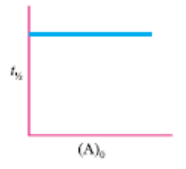Complete Solutions to LONG ANSWER TYPE QUESTIONS of chapter CHEMICAL KINETICS of Class 12 book with complete answers and questions
| Class 12 | CHEMISTRY |
| Chapter | CHEMICAL KINETICS |
| SUPPORT MATERIAL | LONG ANSWER TYPE QUESTIONS |
| Number Of Questions | 12 |
| Academic Year | 2023-24 |
Define 'order of a reaction'.
01:05View SolutionRates of reaction double with every `10^@` rise in temperature. If this generalization holds for a reaction in the temperature ranges 298 K to 308 K, what would be the value of activation energy for their reaction ? R = 8.314 J `K^(-1) "mol"^(-1)`.
04:12View SolutionWhat are pseudo order reaction ? Give example.
03:05View SolutionThe rate constant 'k'. For a reaction varies with temperature 'T' according to the question. `log k = log A-(E_(a))/(2.303R)(1/T)`
Where `E_(a)` is the activation energy. When a graph is plotted for `log k vs 1//T`, a straight line with a slope of `-4250` K is obtained. Calcualte `E_(a)` for this reaction.03:31View SolutionDetermine the units of rate constant for first and zero order reaction.
02:17View SolutionShow that time required for the completion of 99% of the first order reaction is twice the 90% of completion of the reaction.
03:23View SolutionDefine rate constant of reaction.
01:46View SolutionA first order reaction takes 40 min for `30%` decomposition. Calculate `t_(1//2)`.
01:59View SolutionDetermine the order of reaction and also determine the units of rate constant
 02:20View Solution
02:20View SolutionThe following data were given for thermal decomposition of `SO_2Cl_2` at a constant volume :
`SO_2Cl_(2)(g) to SO_2(g) + Cl_(2) (g)`

Calculate the rate of the reaction when total pressure is 0.65 atm.06:56View SolutionThe energy of activation for a reaction is `100 KJ mol^(-1)`. The peresence of a catalyst lowers the energy of activation by `75%`. What will be the effect on the rate of reaction at `20^(@)C`, other things being equal?
07:47View SolutionA + 2B`to` 3C + 2D
The rate of disappearance of B is `1xx 10^(–2) "mol L"^(–1) "sec"^(–1)`. What will be (i) rate of reaction (ii) rate of change in the concentration of A and C ?06:17View Solution
LONG ANSWER TYPE QUESTIONS questions and complete solutions for chapter CHEMICAL KINETICS of CBSE COMPLEMENTARY MATERIAL CHEMISTRY (HINGLISH) of Class 12
